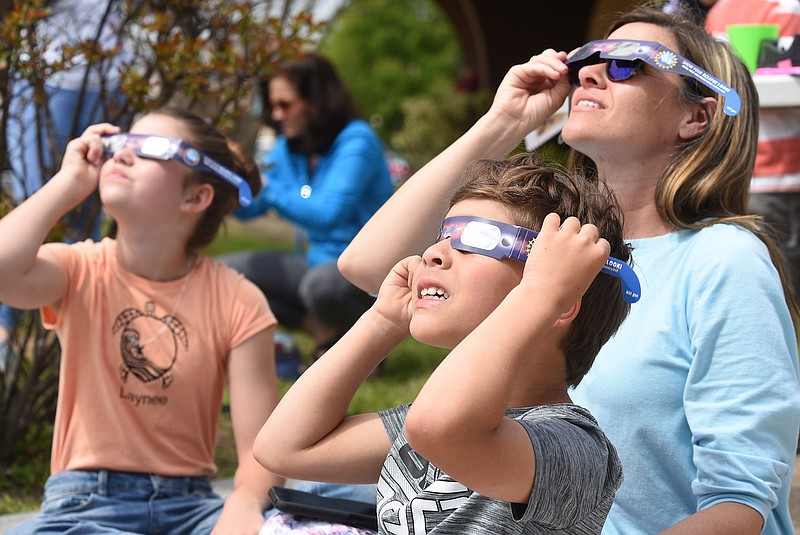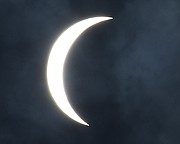Despite cloudy weather, dozens of Chattanoogans looked to the sky Monday afternoon outside the Northgate branch of the Chattanooga Public Library as a total solar eclipse made its way across North America.
In addition to providing eclipse-viewing glasses, the library branch had activities for children to learn about and have fun with the astronomical phenomenon, including making bookmarks with ultraviolet light-reactive beads, sketching the eclipse with chalk and paper and making pinhole viewers to project the image of the eclipse onto the ground. Ann Walton, teen and tween programmer at the library branch, said the activities and communal viewing added to an already unique occurrence.
"It's fun to be around people with this kind of event that's so rare and fun to see," Walton said in an interview.
(READ MORE: Blind people can hear and feel April's total solar eclipse with new technology)
Monday's eclipse passed over the U.S. from the southwest to the northeast, from Texas to Maine, in a wider path of totality than the previous total solar eclipse in 2017, which crossed the U.S. from the northwest to the southeast, according to NASA. During a solar eclipse, the moon passes in front of the sun, blocking all or part of it, with the totality being the point where the moon completely covers the sun, revealing the star's outer atmosphere — the corona — according to NASA.
While Chattanooga was outside the path of totality, Sean Lindsay, senior lecturer and astronomy coordinator at the University of Tennessee in Knoxville, previously told the Chattanooga Times Free Press the city would see an 88% partial eclipse.
"That means there's only a thin sliver of the sun visible," Lindsay said. "That's enough of an eclipse, you'll notice right around the maximum eclipse, it'll get noticeably darker. It'll be a larger partial eclipse than the one we had in October 2023, so if anybody enjoyed that, this one they'll enjoy a good bit more."
For some children in attendance, it was their first eclipse experience. Robyn Logan and her son, Asher, stopped by the library after an appointment to watch the eclipse. Asher wasn't born yet to witness the previous total solar eclipse in 2017, Logan said. Seeing the eclipse with her son added to the excitement of the event, she said.
"This morning he was asking about it before he went to preschool, and when I picked him up from school, he was talking about special glasses and watching the sun and the moon today, so that was really exciting to hear his excitement," Logan said.
(READ MORE: Solar eclipse playlist: 20 songs to rock out to on your cosmic adventure)
(READ MORE: Solar eclipse playlist: 20 songs to rock out to on your cosmic adventure)
For Pamela White, an Ooltewah resident, the library's event provided an opportunity to watch the eclipse with her family, including her eldest daughter and grandchildren. White previously saw the 2017 eclipse while living in Nashville, saying it was educational from a scientific and historical perspective.
"It's a continuity of seeing what something occurred so far back centuries ago that continues to occur, and so it's fascinating," White said of the phenomenon in an interview, adding that Monday's astronomical event was an opportunity to tell the children they will have future opportunities to see an eclipse.
The next total solar eclipse viewable in the U.S. is expected on Aug. 23, 2044, according to NASA.
Contact Sam Still at sstill@timesfreepress.com or 423-757-6579.

